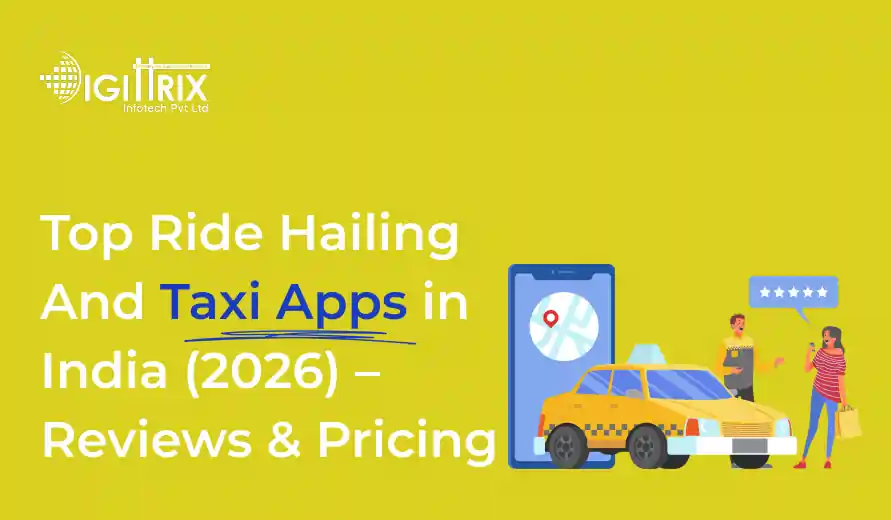India’s ride-hailing market grows rapidly in 2026, driven by eco-friendly cabs, affordable bike taxis, and advanced ridesharing apps, enhancing convenience for millions of urban commuters.
Highlights
An enthusiastic developer and skilled business management expert with over a decade of experience in the field

India’s transportation system has undergone a major change over the past decade, thanks to the rise of digital ride-hailing and taxi apps. Today, millions of Indians depend on these platforms daily for work, shopping, education, and leisure travel. As the country moves into 2026, the ride-hailing industry continues to expand, fueled by urbanization, smartphone use, and growing acceptance of cashless transportation options.
This detailed article covers the leading ride-hailing and taxi apps in India for 2026, including their features, reviews, pricing, and the reasons for their popularity among riders. We also analyze how trends like ridesharing app development and taxi booking app development are influencing both startups and established companies entering this industry.
Curious about how shared rides are optimized? Check out Digittrix’s insights on smart routing algorithms for shared rides to discover how efficiency meets convenience!
Founded in 2010, Ola remains the most recognizable name in India’s app-based transportation ecosystem. It serves millions of riders across metros, towns, and tier-2 cities.
Ola users frequently mention the convenience of quick bookings and professional drivers. Some feedback concerns surge pricing during peak demand hours.
Base fares begin around $ 45–$ 50, with rates varying depending on vehicle type, city, and distance. Electric rides are a bit cheaper because of lower fuel costs.
Ola’s success story serves as a benchmark for ridesharing app development teams aiming to build scalable, customer-centric mobility platforms.
Uber has firmly established itself as a household name in urban mobility. The company’s expansion in India includes cabs, autos, and even intercity options.
Commuters value Uber’s clean vehicles and reliable app. While occasional cancellations are still a concern, overall satisfaction remains high.
Uber’s fares begin at $50, varying with demand and distance. Subscription plans like Uber Pass offer extra savings.
For startups, Uber demonstrates how a global ridesharing app development company can tailor services to match local user behavior.
Rapido has transformed short-distance travel in India. By providing two-wheeler rides, it shortens travel time and helps users avoid traffic congestion.
Users appreciate its affordability and punctuality. It’s the preferred app for office commutes and student rides.
Average fares range from INR 6 to INR 9 per kilometer. Rapido serves as an inspiration for developers thinking about creating carpooling apps that focus on accessibility and affordability.
InDriver differs from traditional ride-hailing services by letting passengers negotiate their fares. This transparency provides more control for both riders and drivers.
Riders value the ability to suggest a price. Drivers also favor flexibility over fixed fares. Some users note minor inconsistencies during peak hours.
Prices fluctuate based on user negotiation but usually are 10–15% lower than average taxi fares.
For developers, InDriver’s model demonstrates how innovative thinking in taxi app creation can challenge traditional pricing models and draw in price-conscious users.
BluSmart has become a symbol of sustainable urban mobility. Operating an all-electric fleet, it provides clean and quiet rides in major cities.
BluSmart customers often mention the comfort, punctuality, and satisfaction they feel from contributing to a greener environment.
Starting fares typically range from $ 30 to $ 35, with flexible adjustments based on distance. Slightly higher prices are balanced by more reliable service.
BluSmart is transforming the on-demand ridesharing experience by integrating sustainability with passenger comfort.
One of India’s first organized cab services, Meru has successfully adapted to the digital age. It caters to both corporate clients and individual users effortlessly.
Users appreciate Meru’s punctuality and transparent billing. Its longstanding credibility makes it a trusted brand among corporate travelers.
The starting fare is approximately $50, depending on the vehicle and location. Prepaid bookings and intercity packages are available.
Meru’s longevity demonstrates how traditional businesses can adapt through mobile app development strategies to stay relevant in a digital market.
Jugnoo started as an auto-rickshaw booking app and has expanded to offer various mobility options. It serves users who want affordable rides for daily errands.
Customers value low prices and easy navigation. Some mention limited driver availability during off-peak hours.
The base fare begins at approximately $ 30–$ 35, making it very affordable.
Jugnoo’s localized approach demonstrates how targeted carpooling app development can meet specific commuter needs in small and mid-sized towns.
Savaari is the preferred app for those seeking comfortable intercity travel or day-long rentals. It connects the convenience of affordable transportation with the convenience of personal car ownership.
Users praise punctuality, simple booking, and vehicle quality. Perfect for families and business travelers.
Rates begin at INR 9 to INR 12 per mile. Hourly and full-day rental options are also available.
Savaari’s service model is a great example for entrepreneurs developing taxi booking apps for outstation or rental-based transportation.
Quick Ride specializes in office carpooling and has quickly expanded in corporate centers like Bengaluru, Pune, and Hyderabad. It allows users to share rides with verified professionals.
Corporate professionals choose Quick Ride for cost savings and community building. It decreases both traffic and carbon emissions.
The app’s fares are determined by distance and the number of riders. It usually costs 50–70% less than regular cabs.
Its community-focused approach shows how on-demand ridesharing apps can build sustainable commuting systems.
Built on India’s ONDC framework, Namma Yatri exemplifies the new wave of open digital platforms. It’s especially popular among auto drivers in Bengaluru.
Riders appreciate its fairness and affordability. Drivers value the zero-commission model that boosts their income.
Rides start at INR 30 and adhere to government-approved rate cards. It’s both ethical and cost-effective.
Namma Yatri’s growth exemplifies how a ridesharing app development company can work with open-source networks to empower local drivers.
Yatri App, supported by the Mumbai Auto Rickshaw Association, provides fair prices and simple booking for local rides.
Riders choose Yatri for transparent pricing and ease of use. It has helped rebuild trust between passengers and drivers.
Follows Mumbai’s government-approved fare structure. No hidden fees.
Apps like Yatri demonstrate how community-driven mobile app development can foster trust at the local level.
The Indian ride-hailing market is expected to surpass INR 80,000 crore by 2026. Several factors are contributing to this growth.
This environment creates immense opportunities for entrepreneurs investing in ridesharing app development or taxi booking app development for different markets.
When designing an app with assistance from a ridesharing app development company, these factors should be central to the design and functionality.
Despite impressive growth, challenges persist:
Innovative mobile app development solutions address these concerns by incorporating advanced security features, route optimization, and fair-pricing algorithms.
Entrepreneurs entering this sector need to design efficient backends, user-friendly interfaces, and a well-balanced pricing structure—essential elements of successful ridesharing app development.
Creating a practical and user-friendly taxi app requires technical accuracy and a thorough understanding of the market. A professional ridesharing app development company can help by offering:
Whether you’re building a new startup or improving an existing platform, expert taxi booking app development teams can ensure your product runs smoothly across all devices.
In 2026, India’s ride-hailing ecosystem will focus on three major trends:
Sustainability, affordability, and convenience will influence customer expectations. The demand for carpooling app development and eco-friendly services will increase as urban areas promote cleaner transportation options.
Thinking of launching a ride sharing service? Check out Digittrix’s guide to building a ride sharing platform like CITYHOP to jump-start your project!
Ride-hailing in India has progressed greatly, moving from waiting on busy roads for taxis to booking cabs in seconds. By 2026, users will have a wide range of services to choose from, each emphasizing convenience, affordability, or sustainability.
For riders, this competition offers better prices and more options. For entrepreneurs, it presents endless opportunities in ridesharing app development, on-demand ridesharing projects, and mobile app creation for various cities and user groups.
Whether it’s Ola, Uber, Rapido, or BluSmart, each brand showcases India’s changing approach to smarter transportation. As more cities adopt digital solutions and startups enter the market, the coming years will shape a new era of convenience and connectivity on the road.
As India’s ride-hailing market grows quickly in 2026, businesses have a strong chance to tap into the increasing demand for affordable, safe, and tech-enabled mobility options. From large cities like Delhi and Mumbai to rapidly developing places like Chandigarh and Pune, people depend daily on ridesharing and taxi apps for convenience and safety.
If you’re looking to enter this growing market, partnering with a trusted ridesharing app development company is essential. Digittrix specializes in on-demand ridesharing and taxi booking app development, creating intuitive, scalable, and user-focused platforms designed to meet Indian commuters' expectations.
Our team’s experience in mobile app development and carpooling app development guarantees that your platform isn’t just functional but also prepared for the future, designed for performance, security, and growth.
Get in touch with Digittrix today at +91 8727000867 or email digittrix@gmail.com to discuss your project.
Let’s create a modern, reliable ride-hailing app that helps your business grow and keeps your users moving safely, anytime, anywhere.

Do you need help in ?




Join over 1500+ businesses we've already helped!
Ola and Uber remain the most popular ride-hailing apps in India for 2026, offering extensive coverage, safety features, and various ride options.
Yes, BluSmart and Ola Electric provide all-electric cab options in several major Indian cities, supporting eco-friendly and cost-effective travel.
The base fare starts at approximately INR 30 to INR 50, depending on the city, vehicle type, and app platform. Extra charges might apply for longer distances.
InDriver is the only major app that allows users to suggest or negotiate their fare directly with drivers before confirming the ride.

©2025Digittrix Infotech Private Limited , All rights reserved.